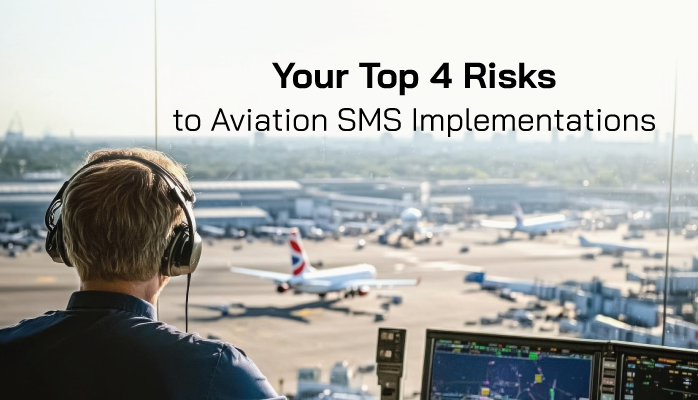What Is an Aviation Safety Management System

Aviation safety management systems are formal, structured methodologies for managing aviation safety programs. ICAO mandated that most aviation service providers implement SMS programs in 2006.
There are guidelines as to aviation SMS requirements that most SMS professionals are familiar with, notably Document 9859. Doc 9859 nicely outlines what is an SMS program and breaks out the requirements into pillars, most commonly called the four pillars.
If you are reading this, you probably already have started your SMS implementation or are in the planning and research phase. Here we discuss common risks to aviation SMS implementations that EVERY safety manager should be aware of.
We will also offer a few risk mitigation and recovery measures should these risks manifest themselves at your airline or airport.
Related Aviation SMS Implementation Articles
- How to Create an SMS Implementation Plan
- Aviation SMS Implementation Struggles and Solutions
- How to Implement SMS in Small Organizations
Prepare for Risks to Aviation SMS Implementations
Our approach will be to list out very real risks to an airline or airport's safety management system implementation and then provide a couple of suggestions.
1. Loss of Upper Management Support
If you never had top management support, then you never had an aviation SMS. Loss of top or upper management support can be attributed to:
- Change in top-level leadership;
- Changing attitudes toward the aviation SMS due to other strategic opportunities/challenges; or
- Safety management team not doing their jobs regarding regular communications with upper management.
To regain top/upper management support, the safety manager (or director of safety) will need to start at the very top and open a dialog with the accountable executive. Topics to enforce include:
- Requirements of the aviation SMS;
- Benefits of the aviation SMS;
- Importance of top/upper management support;
- Methods to demonstrate top-level support of the aviation safety program.
Visible demonstrations of top-level support of the safety program are paramount to the success of any airline or airport safety program. Common displays of top-level support include:
- Newsletter articles from the accountable executive detailing the importance of the SMS;
- Offering regular (weekly or bi-weekly) meetings with the safety manager; and
- Occasionally walking through the area of operations with the safety manager to demonstrate that the safety team has upper management's support.
2. Loss of Safety Champion

Safety champions are incredibly important to the initial stages of any aviation SMS implementation. Safety champions are charismatic, great communicators, and have the ability to get disparate teams to work together.
We recommend every airline or airport that is considering an SMS implementation search for the SMS champion. Safety champions are instrumental in minimizing resistance to change. Safety champions are not always safety managers or the director of safety. They may come from another department.
If your safety champion is not a safety manager or part of the safety team, ensure that the SMS program is well-developed before pulling your safety champion from your SMS implementation project.
3. Loss of Safety Manager
The number two reason for aviation SMS implementation failure is the loss of the sole safety manager. I have seen this repeatedly over the years. Safety managers are key personnel and if the corporate knowledge leaves the company, the safety program will collapse.
Strategies to minimize this risk include:
- Having another "part-time" safety manager who understands how the safety program functions;
- Requiring 30-day notices before key personnel leave the company to be "eligible" for rehire; and
- Training department heads in safety program activities.
Having a part-time safety manager is ideal; however, smaller organizations are reluctant to assign additional resources to their airline or airport's safety program.
An excellent alternative to the part-time safety manager is to actively involve department heads in the workings of the SMS. There will be additional benefits, including:
- Increased involvement and buy-in to the safety program; and
- Improved responsiveness toward risk management activities.
Related Safety Manager Articles
- What Makes a Good Aviation Safety Manager?
- Career Advice for Aspiring Safety Managers
- How to Tell If Aviation Safety Manager Is Doing Their Job
4. Loss of Safety Data
Approximately 5% of companies will have an SMS implementation that is supported by the safety manager's personal laptop. Safety documentation will include:
- MS Word documents;
- Email (in Yahoo, Gmail, or Hotmail accounts);
- MS Excel spreadsheets; and
- Home-made MS Access databases;
Imagine the horror when your safety manager leaves the company and takes your valuable safety data with him. The ex-safety manager may leave the company with little regard for the success of your airline or airport. In this case, recovering your safety data will be next to impossible. A spiteful safety manager will simply delete the data or use the structure for his next career opportunity.
Mitigation strategies for loss of safety data include:
- Utilizing in-house centralized databases and file systems;
- Using cloud-based, professionally designed aviation safety management system solutions; and
- Enforce regular backup strategies for all company data.
Last Words on Minimizing Risk to Aviation SMS Implementations
Recognition and awareness of risks to your aviation SMS are the first steps to mitigating the risk. A best practice is to manage hazards and risks proactively in safety management tools, such as a "Proactive Hazard Analysis Tool." The better proactive hazard analysis tools are integrated into your aviation SMS Hazard Register and hazard risk management processes.
Proactive hazard analysis tools list out hazards and risks. These hazards and risks will then be risk-assessed and treated with mitigation and recovery measures. Lastly, these hazards are to be regularly reviewed to ensure your mitigation and recovery strategies remain relevant to your airline or airport's needs.
Commercially available and low-cost SMS database software speeds up SMS implementations in many ways. You can rely upon the database to not walk out the door when your safety manager leaves. Furthermore, SMS database software adds structure to your SMS and subsequently reduces risk.
In short, if you want a professional SMS, it pays to acquire professional SMS tools that guide you in your SMS implementation.
Hazard Reporting Solution offers all tools to begin your SMS implementation, including
- Gap Analysis Tools (with most popular models);
- SMS Implementation Plan Manager;
- Reactive risk management tools;
- Hazard reporting;
- Corrective actions and preventive action tracking.
Last updated in December 2025.






